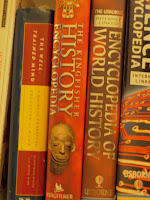A couple of years ago, a few of our moms turned me onto the series by Susan Wise Bauer, "Story of the World" for history. They had been using it and found it provided straightforward, general history lessons, with tons of resources for diving deeper into each lesson. Rather than spending a few weeks on one era of human history in each year of school, it comprehensively covers a block of history each year, over a four year period. In doing so, it takes four school years to cover the whole series, BUT being that it spends so much time on the subject matter, the goal is that children will retain more of it.
In purchasing the books, you can buy a kit, such as pictured, which includes the main instruction book to read the lessons and storyline, a student kit with questions, discussions, maps of the time, and workbook pages, a test/answer book, plus a second student workbook, in case you don't want to write in your book, but make copies. Please save yourself some pain, and order the additional books for around $15 each. The set sells for around $70 from peacehillpress.com.
The series is divided by eras.
Year One (Volume One): Ancient Times
Year Two: The Middle Ages
Year Three: Early Modern Times
Year Four: The Modern Age
Since the activities on the student pages vary in difficulty, to cover all age levels, the idea is that you'd cover four years from first grade through fourth, using the coloring pages, maps, and more hands on learning, like the "make it yourself" quill pen, that the Monks used to write early books. Then, when the material is repeated from fifth to eighth grade, the student is already familiar with the subject and can do the more sophisticated work, like reading a book on the early Church or a related novel like The Odyssey. Books can be obtained from the library, some of them are even available on a cd to listen to in the car. And if you really want to get high tech, the main instructor book with the lessons and stories can be purchased for an mp3 player, so they can listen to it independently, at least as a review, perhaps as something productive to do while you are working with another child!
Obviously the big selling point for me was that I can provide all my children's history work in ONE class, not five! We do the initial lesson together, then we all do the discussion and review questions. While the younger ones are doing the coloring or map activity, Elizabeth and I have a more sophisticated discussion or project or if the younger ones need me, she works on some literature that fit into the time period.
The author suggests another four year period could follow in high school. That may be true and may meet the state requirements, but I will likely use other programs in high school, primarily to expose my children to different styles of curriculum and to meet specific state requirements.
If you do give these books a try, you may want to purchase some supplemental materials. The author has references to these supplemental books in each lesson, so you don't have to fish for resources.
The Usborne Internet Linked Encyclopedia of World History has Internet links so you can get online and actually take a virtual field trip to the Great Wall of China or look at the tombs of ancient Pharaohs.

The Kingfisher History Encyclopedia has great pictures of ancient artifacts and depictions of ancient life with descriptions of the timeline.
The Well Trained Mind is a guide to classical education by Susan Wise Bauer and has a list of suggested literature for children of every age and subject matter. Know that Bauer is a christian and makes it known in this book, but not so much in her history series. I have seen no anti-Catholic references so far, but if I did, I'd use it as a chance to educate them further about our faith, as we all do in the many areas of our lives.
Another recommendation in doing this series is to make a living timeline in your home of the era you are studying (a long hallway would work or maybe put it in a notebook in sequential pages), so when you are studying these significant people and events you can also use the same timeline in all of their subjects. When did Mozart compose his great works (music)? When did Ely Witney make the cotton gin (science)? When did Pope Leo become Pope (religion)? Personally, I have not made it to this yet, but I love the idea.










No comments:
Post a Comment